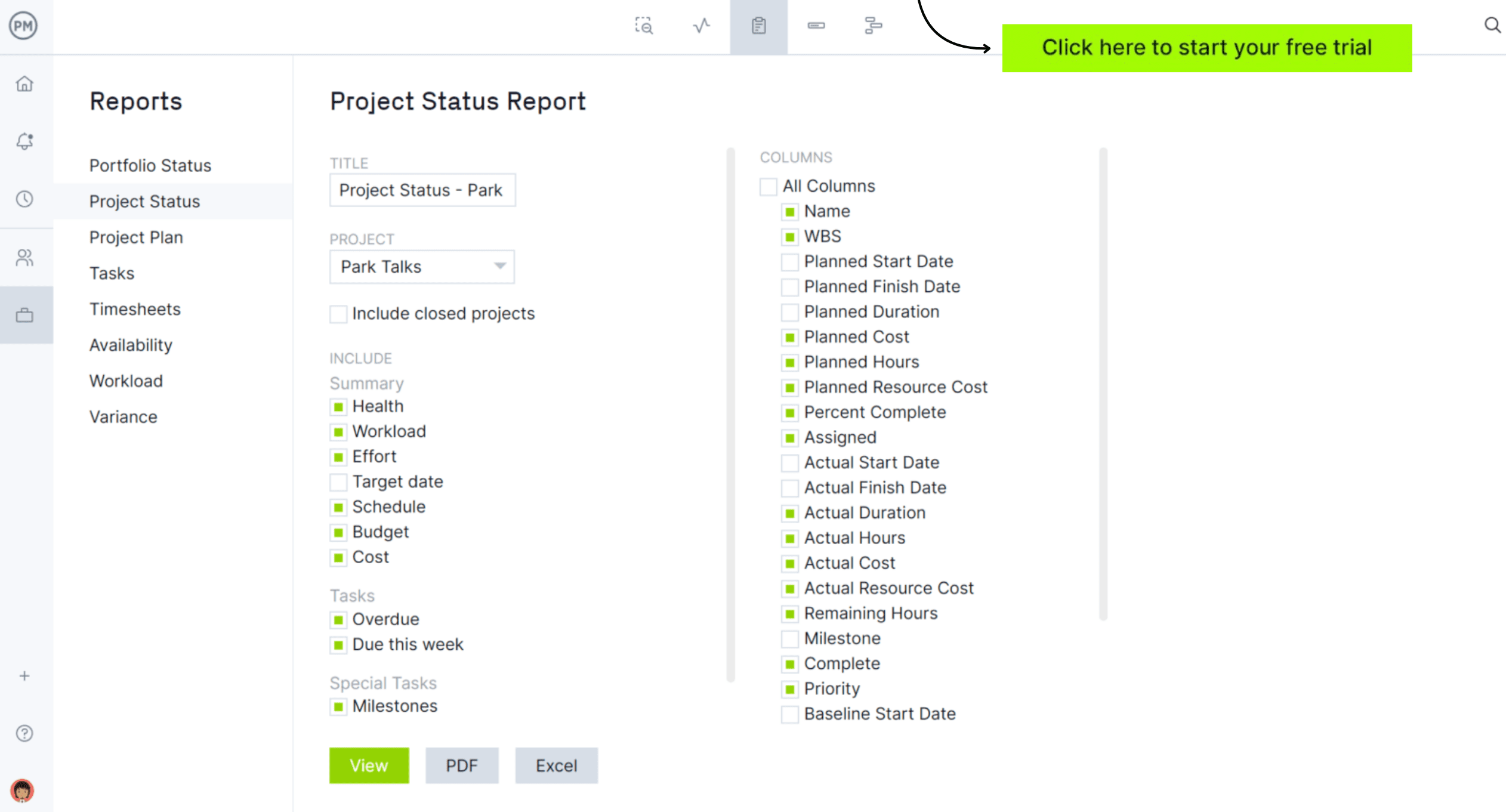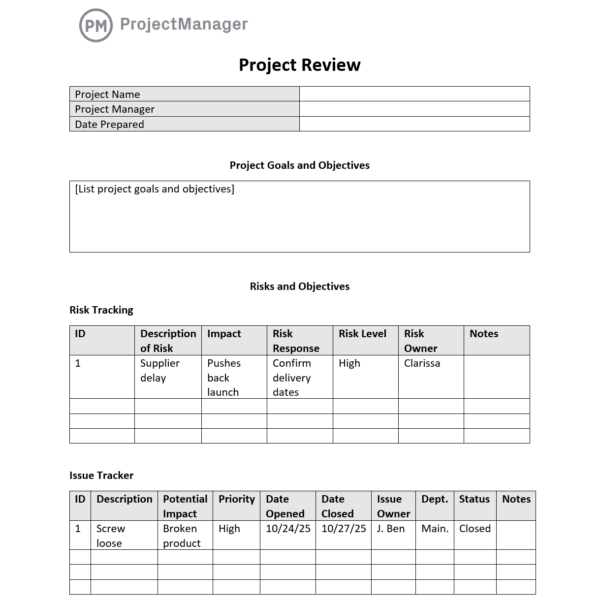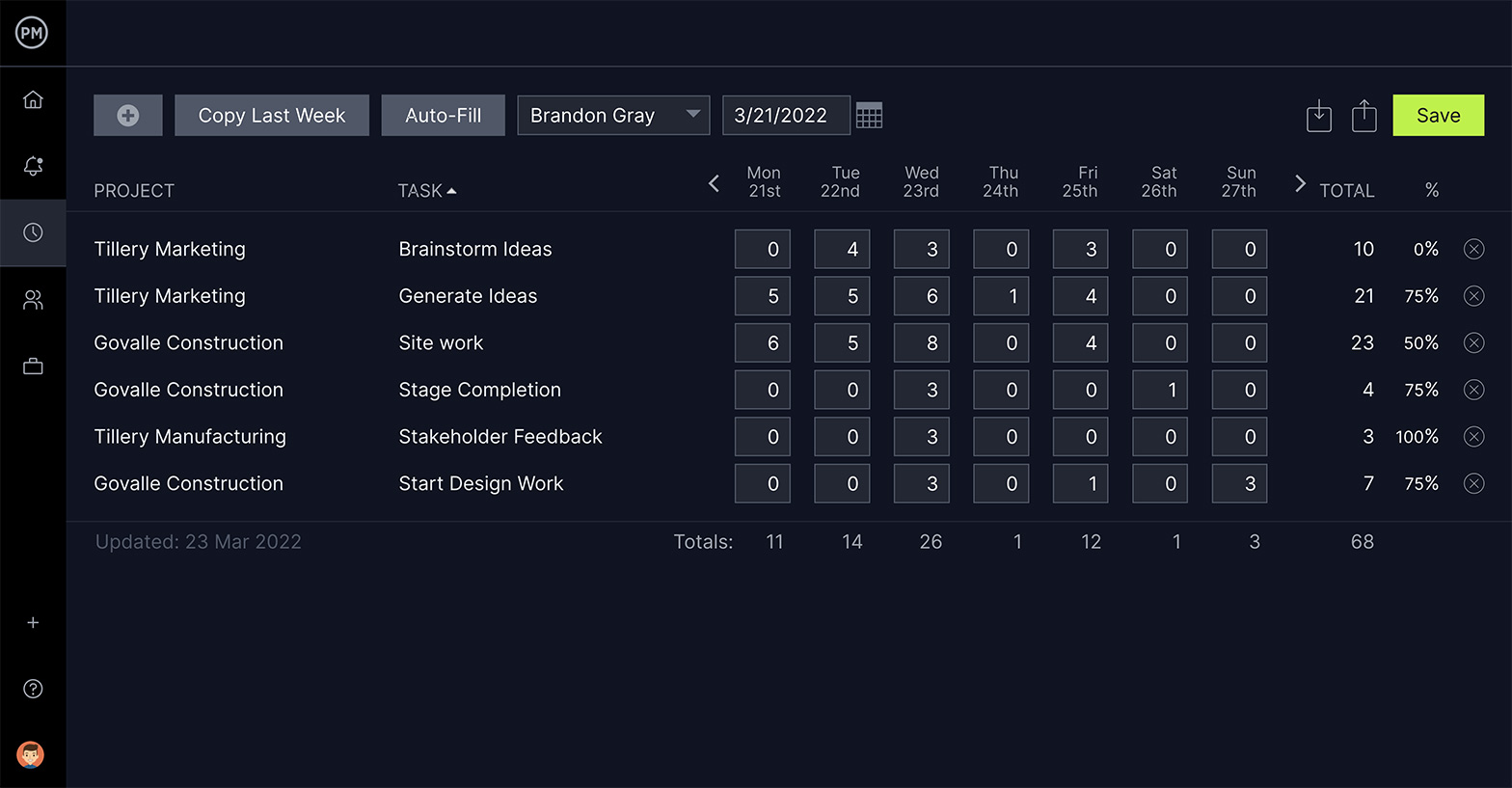In short, a post-implementation review is a process to evaluate whether the objectives of the project were met. You can also use it to see how effectively the project was managed. This helps to avoid making similar mistakes with future projects and learn how to run the project better.
Post-implementation review is the last step in your project cycle and usually involves an independent party, which can act more objectively in making their determinations about how the project was run. This provides the stakeholders of the project the confidence to know that the objectives of the project were met successfully.
How do you lead a post-mortem on your project to learn how to repeat the good stuff and lose the bad stuff? Read on.
What Is a Post-Implementation Review?
What are you going to do when the project’s over? Have a little celebration and move on to the next one, right? That’s not best practice. The project might be over, but the post-implementation or post-project review process continues.
That means that if you delivered a product or a service, the project might be completed, but you still need to check on the viability of the product or service. You might have achieved the goals you set out for the project, but what about the business needs that product or service was responding to?
Think of it as an ongoing step in your project closure process. It’s a post-project review or post-implementation review, which is part of your project management responsibilities. It’s also a great way to identify project successes, deliverables and achievements and learn lessons from those parts of the project that didn’t work out as planned.
ProjectManager is award-winning project management software that has the tools to plan and track project data through every phase. Plan project details carefully on the Gantt chart and use dashboard and reporting features to catch bottlenecks. In a few clicks, download the reports and share them with stakeholders to let them know whether the project’s goals were met. Get started with ProjectManager today for free.

How do you practically apply a post-implementation review? How can you be sure that the project solved the problems it was created to address? Are there more benefits that can be unpacked from the project? What are the lessons learned? To answer those and more questions, you need to follow a process.
Post-Implementation Review Process: 11-Step Checklist
To get the most out of your project, you want to employ a post-implementation review process. While this can start at any time after the project plan has been executed, starting it sooner than later makes sure that the project details are still fresh in the team’s mind.
While to get the most from the process, you’ll want to wait a while, after the project’s product or service has had time to exist in the real world. But at least start the process by beginning to list ideas and observations. You don’t want to wait until the participants are distracted by other projects.
Each project team can develop its post-implementation review process to make it as detailed as needed, but here are some general post-implementation review steps that can be applied to any project. These can be used to make a unique post-implementation review checklist.
1. Review Project Goals & Objectives
Look over the goals and objectives of the project to determine if the deliverables functioned as planned. Calculate the error rate of the project. Review the deliverables to see if they adjusted to changes in the market. Figure out how well-trained and supported end-users are. List the controls and systems that are in place and if they are working. Make sure that problems are being addressed. Find out if the planned goal aligned with the results.
2. Determine Whether Project Success Criteria Were Met
Before the project began, a set of project criteria was established. This is used during the execution phase to ensure that there is a way to measure the project. Not that the project has been implemented, review those project success criteria to see if they were met.
3. Assess the Project Constraints
Next, review the project constraints. A project constraint is any limitation that can affect a project’s ability to be completed successfully. There are project constraints to look over.
- Time: Determines whether the project can be completed within the planned timeframe.
- Scope: Whether the project can be completed as originally detailed, including client requirements and the features and tasks needed to meet those expectations.
- Cost: Looks at if the project is completed within the budget.
- Quality: Maintains the quality standards as expected by the client.
- Resources: Limitations on the availability of resources that are necessary to complete a task or achieve an objective.
- Risk: Risks can be positive, as in opportunities, or negative, as in threats, which can occur anytime throughout the project’s life cycle.
4. Get Feedback From Internal & External Project Stakeholders
Stakeholder feedback can help identify strengths and weaknesses and guide improvements for future projects. Therefore, the project manager should identify all internal and external stakeholders and determine their level of interest and influence as well as regularly meet with them throughout the life cycle of the project.

Get your free
Project Review Template
Use this free Project Review Template for Word to manage your projects better.
5. Conduct a Gap Analysis
Gap analysis is the method of assessing how a plan differed from the actual application, and is always a powerful tool to see what benchmarks you met, and which you didn’t. You can start with your project charter and see how closely you adhered to your objectives. Look at your deliverables. Are they at the quality level you expected? When there are gaps discovered, figure out how they can be closed.
6. Determine the Cost-Benefit Ratio of the Project
A cost-benefit ratio is an indicator showing the relationship between the relative costs and benefits of a proposed project, expressed in monetary or qualitative terms. If a project has a cost-benefit ratio of greater than 1,0, the project is expected to deliver a positive net present value. This cost-benefit analysis can determine if the project’s benefits outweigh its costs.
The questions below can help gather conclusions from a cost-benefit analysis after the project has been completed.
- Cost: How much did the project end up costing? What are the costs involved in operating the project’s result? Are the costs aligned to the benefits of the project? If this isn’t the case, how can you improve the cost next time?
- Benefits: Did the project achieve the benefits projected, and if not, why, and how can that be improved? What opportunities are there to further the results? Are there other changes you could apply to help maximize the project’s results?
7. Review the Change Management Log
The change management log serves as a formal record of requests for change, including details, impact assessment, decision-making, implementation status and closure. This not only provides transparency, accountability and effective management of changes, but when reviewed post-implementation can help review if change was managed successfully or not.
8. Compare Estimated vs. Actual Costs
When making a project budget, all project costs are estimated. As the project is executed, those costs should be tracked. Comparing the estimated costs to the actual costs helps keep the project from going over budget when executing the work and, afterward, shows if and when the project went over budget. It can also hint as to why this happened.
9. Evaluate the Individual Performance of Team Members
While it depends on the project, in general terms all project managers want to compare hours worked against their deliverables to determine who was productive. By measuring each team member’s performance, project managers can see who delivered as expected and who didn’t. This data can help refine the management of future projects to help teams perform better.
10. Make a Lessons Learned Document
A lessons-learned document is a great tool to capture what worked and what didn’t work in a project so that information can be applied to future projects. This allows managers to take advantage of what is positive about a project and resolve the negative aspects. This process should include all team members, stakeholders and even vendors and suppliers.
11. Make a Post Implementation Review Report
Make a post-implementation review report to document what you learned from the review, whether there are actions needed to get the beneficial results you want and list the lessons you’ve learned, noting how the project can impact future projects, so you can build on success and avoid problems.\
Project Review Template
Use this free project review template for Word to kick-start your post-implementation review process. It has all the essentials to evaluate the success of your project, so you can make improvements for next time.

How to Conduct a Post-Implementation Review
After the project’s deliverables have gone through at least one successful business cycle, you can get started on the review. There are project closure checklists that help frame the process. Here are some of the best practices for conducting the review:
- Trust. To get the information you need, you want honesty from your participants. Therefore, tell them you want openness, without fear of retribution. The more critical and truthful their observations about the project are, the more successful the review.
- Objectivity. While you want honesty, you don’t want sour grapes or interpersonal issues clouding observations with bad feelings or to settle old scores. Seek objectivity, or as close to an impartial critique as can be expected.
- Documentation. Like all project management, you want to create a paper trail that illustrates how you went from Point A to Point B. By documenting the practices and procedures that created the successes in the project, you’ll be able to follow them again in future projects.
- Hindsight. As you develop a narrative as to what worked and what didn’t, what surprises arose during the project and how you dealt with them, understand that this hindsight vision can also help as you look forward towards new projects.
- Improvement. The point of this review process is not to blame individuals or teams for mistakes but to learn from experience and then apply that knowledge to future projects. Stay focused on what’s next, rather than looking back as a means of applying guilt.
Benefits of Post-Implementation Review in Project Management
There are many potential benefits to making a post-implementation review after a project is finished. Here are some of them.
- Allows organizations to gather information that will help plan future projects
- Findings from post-implementation reviews are factored in during the project intake process when project management offices (PMOs) prioritize projects
- Helps to zoom into key project management areas such as resource management, cost tracking or risk management beyond project reports
- Conducting regular post-implementation reviews greatly improves the project management maturity of an organization
- Post-project reviews help organizations assess the effectiveness of team leaders such as project, program, or project portfolio managers.
More Free Post-Implementation Review Templates
To help with the post-implement review process, download the following free templates. There are over 100 free project management templates for Excel and Word on our site. They can help manage every phase of a project across multiple industries. Here are a few links to free post-implementation review templates.
Post-Mortem Template
A post-mortem is used to examine a completed project and provide a structured post-implementation review and analysis. Use this free post-mortem template for Word when getting feedback from teams and stakeholders.
Lessons Learned Template
The lessons learned template for Excel helps project managers and their teams learn from a post-implementation review to avoid repeating mistakes and improve on winning processes. It helps everyone describe what happened, its impact and more.
ProjectManager Helps Post-Implementation Review
One of the ways to conduct a post-implementation review is by going over the project paperwork. These documents provide hard data on how a project proceeded as planned or went off-track.
If you’ve run your project with ProjectManager, you already have a wealth of information on hand that you can use to look back at the closed project and determine where it went right and wrong. To make recommendations on how to manage projects better in the future, you need a clear picture of how they were managed in the past.
Timesheets for Workload Review
With ProjectManager, timesheets are online and easily submitted by team members and approved by project managers. This provides a window into the allocation of your personnel and if those resources were over-tasked or underused. Maybe they could have been scheduled better or the assignments could have been more balanced. ProjectManager.com’s timesheet feature collects that data and gives you the information you need to suggest improvements.

Report on Tasks and Their Successes
Speaking of tasks, you’ll want to take a deep dive into how tasks were executed. ProjectManager has project management reports that reflect the status of your projects. They show when a task was started, how long it took to complete if there were dependencies, bottlenecks or delays that left teams unnecessarily idle.

Because ProjectManager tasks also collect comments and supporting documents, they are a great resource for looking into the execution of individual tasks and see if there are ways to make the process more efficient. These reports will also help project managers pinpoint the team members who they’ll want to interview during the post-implementation review.
Final Thoughts on Post-Implementation Review
There are many ways to close a project, but too often the post-implementation review is neglected. It’s understandable, as a critical review can open some old wounds.
When you’re dealing with a lot of people and asking them for criticism of the project, there’s the potential to step on someone’s toes and create hurt feelings that can creates some unpleasant political issues within your team or organization. Therefore, be clear that what you’re interested in is not a personal attack, but a systemic overview of process and how everyone together can work towards improving it. That’s why it often helps to hire an independent party to collect the post-project data.
Don’t forget to review all the project documentation. It’ll help you better assess what worked and what didn’t, and provide you with an overview of the project and where there might have been unforeseen holes that you can then fill in with upcoming projects.
When you’re done with the review be completely transparent. Share your findings in a report and make sure everyone has access to these documents. If you want to, it can help if you present the information to the organization. Your goal is to create better projects, and that information isn’t proprietary. Everyone needs to know.
Related Project Closure Content
Closing your projects and evaluating their success is one of the most important stages in the project life cycle. We’ve created dozens of blogs, templates and guides to help you master this process.
- Lessons Learned Template
- Project Closure Template
- Project Review Template
- 5 Steps to Project Closure (Checklist Included)
- Project Evaluation Process: Definition, Methods & Steps
- 10 Steps for Successful Project Completion (Templates Included)
When you’re conducting a post-implementation review, you’re working with a lot of data. That’s why ProjectManager is so useful. Our cloud-based software gathers real-time data on your project and collects it in an easy-to-share manner that can be reported on clearly. Not only does it help plan and monitor your project, but report on it too. See how by taking a free 30-day trial.

